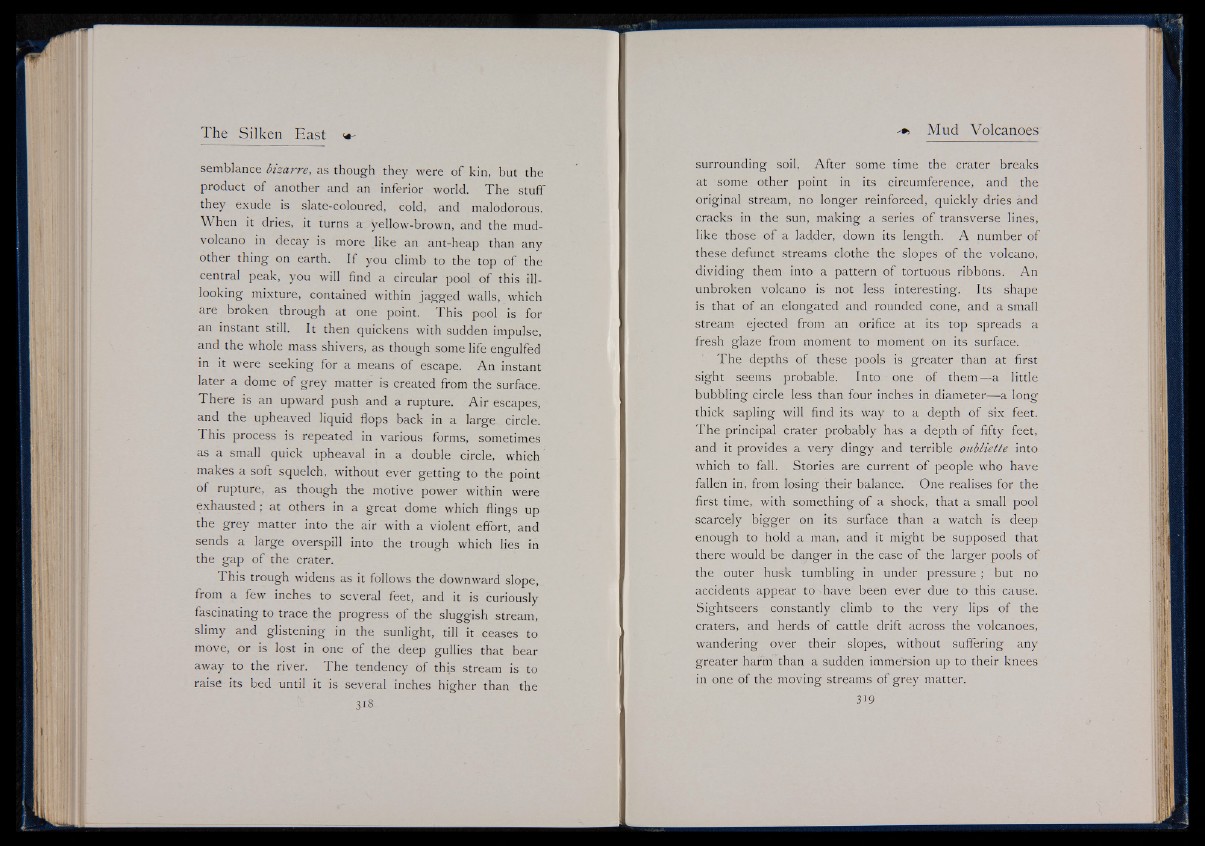
semblance bizarre, as though they were of kin, but the
product of another and an inferior world. The stuff
they exude is slate-coloured, cold, and malodorous.
When it dries, it turns a yellow-brown, and the mud-
volcano in decay is more like an ant-heap than any
other thing on earth. If you climb to the top of the
central peak, you will find a circular pool of this ill-
looking mixture, contained within jagged walls, which
are broken through at one point. This pool is for
an instant still. It then quickens with sudden impulse,
and the whole mass shivers, as though some life engulfed
in it were seeking for a means of escape. An instant
later a dome of grey matter is created from the surface.
There is an upward push and a rupture. Air escapes,
and the upheaved liquid flops back in a large circle.
This process is repeated in various forms, sometimes
as a small quick upheaval in a double circle, which
makes a soft squelch, without ever getting to the point
of rupture, as though the motive power within were
exhausted ; at others in a great dome which flings up
the grey matter into the air with a violent effort, and
sends a large overspill into the trough which lies in
the gap of the crater.
This trough widens as it follows the downward slope,
from a few inches to several feet, and it is curiously
fascinating to trace the progress of the sluggish stream,
slimy and glistening in the sunlight, till it ceases to
move, or is lost in one of the deep gullies that bear
away to the river. The tendency of this stream is to
raise its bed until it is several inches higher than the
318
Mud Volcanoes
surrounding soil. After some time the crater breaks
at some other point in its circumference, and the
original stream, no longer reinforced, quickly dries and
cracks in the sun, making a series of transverse lines,
like those of a ladder, down its length. A number of
these defunct streams clothe the slopes of the volcano,
dividing them into a pattern of tortuous ribbons. An
unbroken volcano is not less interesting. Its shape
is that of an elongated and rounded cone, and a small
stream ejected from an orifice at its top spreads a
fresh glaze from moment to moment on its surface.
The depths of these pools is greater than at first
sight seems probable. Into one of them-¿a little
bubbling circle less than four O inches in diameter— a lonOg
thick sapling will find its way to a depth of six feet.
The principal crater probably has a depth of fifty feet,
and it provides a very dingy and terrible oubliette into
which to fall. Stories are current of people who have
fallen in, from losing their balance. One realises for the
first time, with something of a shock, that a small pool
scarcely bigger on its surface than a watch is deep
enough to hold a man, and it might be supposed that
there would be dagger in the case of the larger pools of
the outer husk tumbling in under pressure ; but no
accidents appear to have been ever due to this cause.
Sightseers constantly climb to the very lips of the
craters, and herds of cattle drift across the volcanoes,
wandering over their slopes, without suffering any
greater harm than a sudden immersion up to their knees
in one of the moving streams of grey matter.